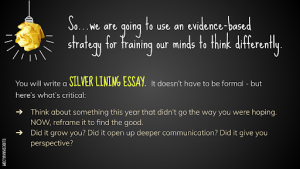As an educator, I continue to love learning and growing. So when I came across a new program sponsored by Blake Mycoskie (founder of TOMS) called Madefor, an action model that provides a foundation for cultivating new mindsets and greater wellbeing, I was interested. When I saw they were offering scholarships for educators to complete the program for free, I was completely in.
The program has ten focus areas: hydration, gratitude, fuel, connection, breath, movement, nature, clarity, rest, and vision. These highly researched focus areas were intentionally chosen to help build positive new habits. Each month I was sent a box with a guidebook, an item (ie: water bottle) and a tracking booklet/bracelet to help me instill new habits during each 21-day period.
Madefor didn’t just send me a box and let me go. They had frequent virtual meetings and a great group of experts, scientists, and clinicians on board to support me. What really piqued my interest in this program was the involvement of neuroscientist Andrew Huberman and former Navy Seal, Patrick Dossett. Patrick co-founded the program and utilized much of his training in the Navy Seals to help those of us participating to grow and learn.
Whenever I see or try something new, I make connections to how this might be utilized in a classroom setting. One of the habits (gratitude) incorporated the idea of silver linings – helping us look at a difficult situation to find the good. I was teaching seniors at the time, and we had just made it through COVID and were wearing masks, trying to figure out what school looks like after the pandemic.
“During my gratitude focus in the Madefor program, I learned that looking for the silver lining was an evidence based strategy for training your mind to think differently.”
Coping mechanisms were at an all-time low. Students needed some help – and I knew brain science was in my corner. During my gratitude focus in the Madefor program, I learned that looking for the silver lining was an evidence based strategy for training your mind to think differently. Basically, students were to do the following: 
- Think about something this year that didn’t go the way you were hoping. NOW, reframe it to find the good.
- Did it grow you? Did it open up deeper communication? Did it give you perspective?
The essay was an informal writing assignment with a rubric focused on purpose, organization and audience – but the focus was to help students access cognitive reappraisal.
Cognitive reappraisal is the act of changing how one thinks about or appraises a given situation. According to ScienceDirect.com, “rather than immersing oneself in angry feelings and thoughts, cognitive reappraisal entails taking a step back and viewing a provoking event in an objective way.”
The assignment wasn’t meant to make students pretend everything in life is perfect or ignore the hurt or pain an event might have caused. The truth is, we are hardwired to expend greater neural activity around bad thoughts than good ones. Negativity bias is a survival mechanism, a primitive-brain response that helped our ancestors sniff out danger.
“The silver linings essay helps students engage in gratitude – redirecting their modern day brains to lower the volume of the primitive brain. The silver linings essay assignment helps students reframe their points of focus to appreciate the good in life.”
Basically, the silver linings essay helps students engage in gratitude – redirecting their modern day brains to lower the volume of the primitive brain. The silver linings essay assignment helps students reframe their points of focus to appreciate the good in life.

Some students were skeptical about the assignment, so I decided to contact Pat Dossett and see if he would be willing to chat with my students. He was glad to join us – and we had a virtual class period where Pat talked about his experience in the Navy Seals. He explained that some of the biggest, strongest men and women who attempted the Seal training would never make it. Why? It didn’t matter how big and strong you were if you couldn’t shift your mindset during training.
Pat went on to tell my students that Navy Seals training is excruciating – and even if you can physically handle the training itself, your mental frame of mind is what will make or break you. He connected his experience to the essay the students were writing, explaining that in any situation, your ability to cognitively reappraise the situation is going to make or break you the same way it affected those men and women training for the Seals.
The Silver Lining Essay assignment is an excellent way to help students step back from a situation and try to find where they grew OR where they might grow in the process. My seniors were able to reflect and take some time to reframe the difficult year they had and look for how they might reclaim some of those difficult moments as growth.
The resulting discussion and reflection was good for all of us – and it continues to be something I practice weekly as an educator. When we promote perspective through writing, our students learn not only the mechanics of writing, they practice skills that will help them throughout their lives. Now THAT’S a silver lining.
Resources
Please login or register to claim PGPs.
Alternatively, you may use the PGP Request Form if you prefer to not register an account.



